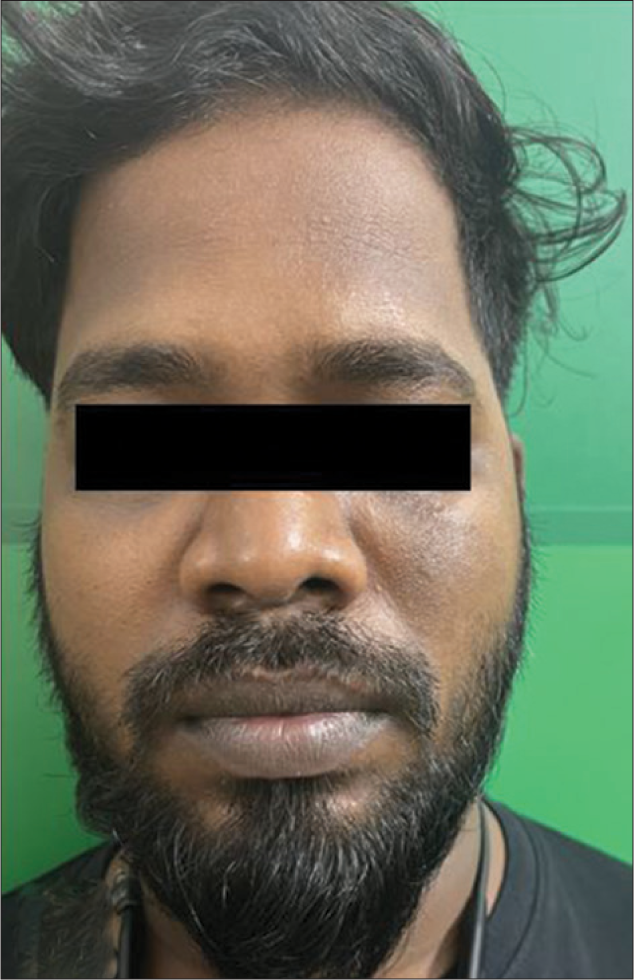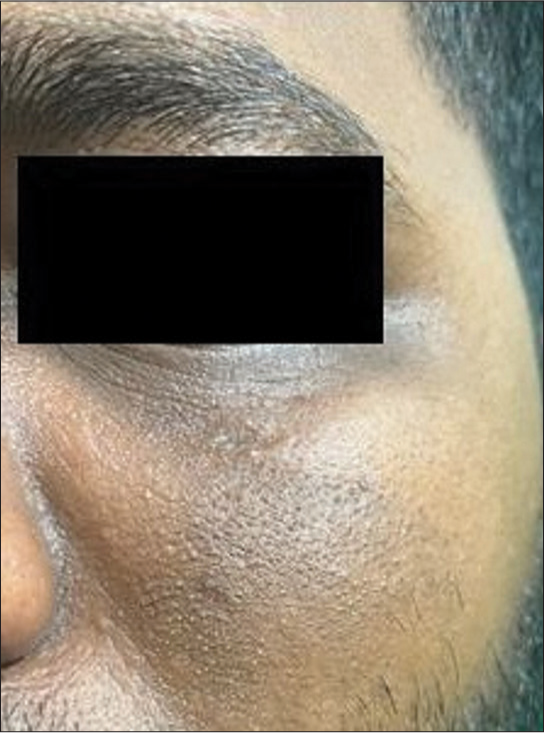Translate this page into:
Traumatic anserine folliculosis
*Corresponding author: Logamoorthy Ramamoorthy, Department of Dermatology, Jawaharlal Institute of Postgraduate Medical Education and Research, Puducherry, India. logamoorthy.r@gmail.com
-
Received: ,
Accepted: ,
How to cite this article: Ramamoorthy L, Rajamani S. Traumatic anserine folliculosis. J Skin Sex Transm Dis 2024;6:107-8. doi :10.25259/JSSTD_7_2023.
A 24-year-old boy presented with asymptomatic roughness of skin over the left cheek of 1 year duration. He gave a history of adopting a particular posture while studying (resting his left cheek on the palm), which led to prolonged friction and pressure on the affected area. Cutaneous examination revealed multiple, discrete, tiny, and skin-colored, grouped papules on the left cheek, which gave a sandpaper-like feel on palpation; the right cheek appeared normal [Figures 1 and 2]. He had acanthosis nigricans of forehead and periorbital melanosis. The patient did not show any evidence of metabolic syndrome and refused a lesional biopsy. Considering the history and clinical findings, we made a diagnosis of traumatic anserine folliculosis. He was advised to avoid trauma and friction to the affected area and treated with topical 0.025% tretinoin cream. He showed 50% improvement after 6 weeks of treatment with topical retinoid.

- Multiple, grouped, discrete, tiny, skin-colored follicular papules over the left cheek.

- Close-up view of multiple, discrete, tiny, skin-colored, grouped papules of traumatic anserine folliculosis.
Traumatic anserine folliculosis is an under-recognized condition characterized by multiple, closely grouped, follicular papules affecting the chin, jaws, and neck. It is referred to as “chin on the palms sign,” when it involves the chin. It is important to differentiate traumatic anserine folliculosis from keratosis pilaris, lichen spinulosus, and other keratotic folliculocentric disorders as the former resolves on avoidance of factors causing friction or pressure. A faster response is attained, when topical keratolytics are prescribed along with removal of etiological factors.
Ethical approval
The Institutional Review Board approval is not required.
Declaration of patient consent
The authors certify that they have obtained all appropriate patient consent.
Conflicts of interest
There are no conflicts of interest.
Use of artificial intelligence (AI)-assisted technology for manuscript preparation
The authors confirm that there was no use of artificial intelligence (AI)-assisted technology for assisting in the writing or editing of the manuscript and no images were manipulated using AI.
Financial support and sponsorship
Nil.





